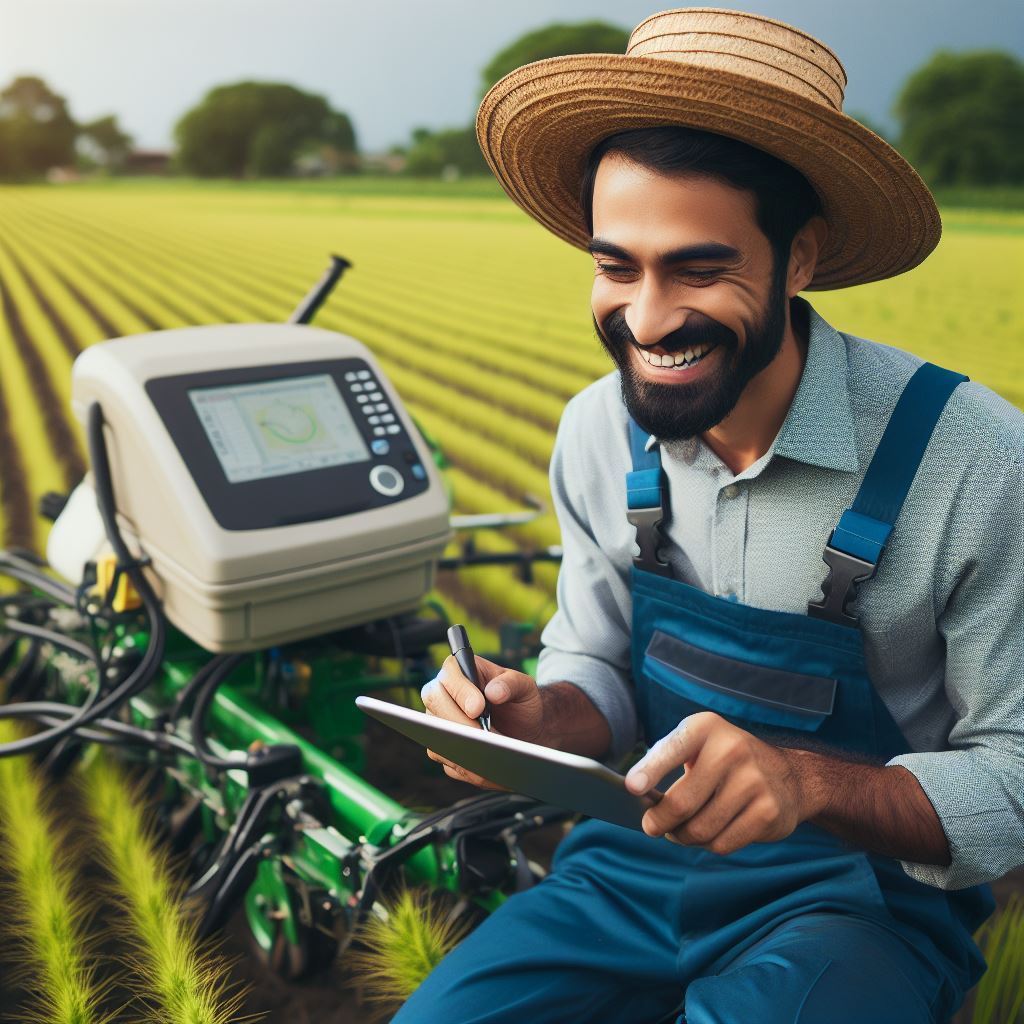Introduction
High-tech farming involves the use of advanced technologies to enhance agricultural practices.
The new age challenge in high-tech farming pertains to effectively managing and maximizing these technologies.
Addressing this challenge is crucial to ensure sustainable food production and meet the increasing global demand.
A. Background information on high-tech farming
High-tech farming utilizes various cutting-edge tools such as drones, sensors, and artificial intelligence.
These technologies enable precise monitoring and control of crop growth, irrigation, and pest management.
The aim is to optimize resource allocation, reduce environmental impact, and improve overall productivity.
B. Explanation of the new age challenge
The new age challenge arises from the complexity and rapid pace of technological advancements.
Farmers must constantly adapt and acquire the necessary skills to grasp and implement these technologies.
Failure to keep up with the evolving high-tech farming practices can lead to inefficiencies and decreased yields.
C. Importance of addressing this challenge
Addressing the new age challenge is vital to ensure the success and sustainability of modern agriculture.
Effective utilization of high-tech farming methods can significantly increase food production and minimize waste.
Moreover, it can contribute to the preservation of natural resources and protection of the environment.
Basically, high-tech farming presents a new age challenge that necessitates proactive measures.
Farmers and agricultural stakeholders must recognize the importance of embracing and effectively implementing these technologies.
By doing so, we can revolutionize the agricultural industry, meet global demands, and create a more sustainable future.
Benefits of High-Tech Farming
In the world of agriculture, high-tech farming has emerged as a new-age challenge and opportunity.
With the advancements in technology, farmers are now able to maximize efficiency and productivity like never before.
In this section, we will explore the numerous benefits that high-tech farming brings to the table.
A Increased efficiency and productivity
- Automation: High-tech farming allows for automation of various tasks, such as planting, irrigation, and harvesting.
This reduces the time and effort required from farmers and increases overall efficiency. - Real-time monitoring: With the help of sensors and remote monitoring systems, farmers can track crop growth, soil moisture, and pest infestations in real-time. This enables timely interventions, leading to better yields.
- Data-driven decision making: High-tech farming provides farmers with access to massive amounts of data.
This data can be analyzed to gain insights into crop health, resource utilization, and market trends, helping farmers make well-informed decisions.
B. Improved precision and accuracy
- Precision agriculture: High-tech farming enables precision agriculture techniques, such as GPS-guided machinery for precise planting and fertilization.
This ensures optimal resource allocation and minimizes waste. - Targeted pest control: Advanced imaging technologies and drones allow farmers to detect pests and diseases early on.
Precise application of pesticides and treatments reduces the risk of crop damage and improves overall yield. - Controlled environment agriculture: High-tech farming includes techniques like hydroponics and vertical farming, where crops are grown in controlled environments.
This eliminates the need for traditional farming practices and provides precise control over factors like temperature, light, and nutrients.
C. Reduction of labor requirements
- Mechanization: High-tech farming reduces the need for manual labor by replacing it with automated machinery.
This not only reduces costs but also addresses the issue of labor shortages in agricultural regions. - Remote operation: Many high-tech farming tools and equipment can be operated remotely.
Farmers can monitor and control operations from a central location, reducing the need for physical presence in the field. - Labor-intensive tasks: High-tech farming focuses on automating repetitive and labor-intensive tasks, such as weeding and harvesting.
This frees up human labor for more skilled and complex agricultural activities.
D. Optimization of resource utilization
- Water management: High-tech farming techniques, like drip irrigation and soil moisture sensors, enable efficient water usage.
This not only conserves a precious resource but also reduces costs and increases crop yield. - Fertilizer optimization: By utilizing precision agriculture methods, farmers can apply fertilizers in targeted quantities based on soil conditions and crop requirements. This minimizes excess use and reduces environmental impact.
- Energy efficiency: High-tech farming promotes the use of renewable energy sources, such as solar power, for various operations.
This reduces dependence on fossil fuels and contributes to a more sustainable agricultural system.
In short, high-tech farming brings a plethora of benefits to the agricultural sector. Increased efficiency and productivity, improved precision and accuracy, reduction of labor requirements, and optimization of resource utilization are just a few of the advantages it offers.
Embracing these technologies is crucial for farmers to meet the challenges of a growing global population and ensure sustainable agricultural practices.
Read: Oregon Berry Farms’ Journey to Eco-Farming
Emerging Technologies in High-Tech Farming
Technology has revolutionized almost every aspect of our lives, and farming is no exception.
In recent years, high-tech farming techniques have emerged, incorporating various breakthrough technologies to increase yields, optimize resource utilization, and enhance overall farm management.
This section explores some of the emerging technologies in high-tech farming.
A. Automation and robotics
One of the most notable advancements in high-tech farming is the use of automation and robotics.
Drones, for instance, are now being employed for monitoring crops, detecting areas that require attention, and even spraying pesticides.
This technology not only improves efficiency but also reduces the need for manual labor.
Another application of automation is in dairy farming.
Robotic milking systems have been introduced to relieve farmers from the demanding task of manually milking cows.
These systems can analyze the individual needs of each cow and automate the milking process accordingly, ensuring the well-being of the animals while maximizing productivity.
B. Internet of Things (IoT) and sensors
The Internet of Things (IoT) and sensor technologies have also found their way into high-tech farming.
Sensors placed in the soil can monitor moisture levels and nutrient content, providing farmers with real-time data that can inform irrigation and fertilization decisions.
This enables farmers to precisely manage resources and prevent wastage.
Livestock tracking has also been revolutionized with the use of IoT and sensors.
Real-time monitoring of an animal’s health and location is now possible, allowing farmers to quickly identify any signs of distress or disease.
This early detection enables prompt treatment, preventing potential outbreaks and reducing losses.
C. Artificial intelligence and machine learning
Artificial intelligence (AI) and machine learning hold immense potential in high-tech farming.
Predictive analytics, a subset of AI, can analyze vast amounts of data to detect patterns and forecast diseases in both crops and livestock.
By identifying early symptoms or indicators, farmers can take preventive measures, minimizing crop loss or animal mortality.
Moreover, AI and machine learning can also aid in crop yield forecasting.
By analyzing historical data, weather patterns, and growth rates, these technologies can provide accurate estimations of crop productivity.
This helps farmers plan their resources and make informed decisions about harvest timing and distribution.
Transform Your Agribusiness
Unlock your farm's potential with expert advice tailored to your needs. Get actionable steps that drive real results.
Get StartedIn essence, emerging technologies such as automation and robotics, IoT and sensors, and artificial intelligence and machine learning are transforming high-tech farming.
These innovations are not only increasing efficiency but also optimizing resource management, improving animal welfare, and enhancing crop productivity.
As technology continues to advance, we can expect even more groundbreaking solutions in the realm of high-tech farming.
Read: Young Farmers: Breaking New Ground

Challenges of High-Tech Farming
A. Initial investment and cost
High-tech farming requires a significant initial investment, including equipment, technology, and infrastructure.
The cost of implementing advanced systems and technologies can be prohibitive for small-scale farmers.
Investing in high-tech farming also involves regular maintenance and upgrading costs to ensure optimal performance.
However, despite the high upfront costs, high-tech farming can yield long-term benefits such as increased productivity and efficiency.
B. Limited infrastructure and connectivity in rural areas
Rural areas often lack the necessary infrastructure and connectivity for high-tech farming.
Poor internet connectivity and limited access to reliable power sources can hinder the adoption of advanced farming technologies.
Without proper infrastructure, farmers may face challenges in accessing real-time data and remotely controlling their farming systems.
Inadequate infrastructure and connectivity also restrict the implementation of precision farming techniques, unlike in urban areas.
C. Data privacy and security concerns
High-tech farming relies heavily on data collection and analysis, raising concerns about data privacy and security.
Farmers often need to share sensitive information such as crop yields, soil conditions, and weather data with technology providers.
There is a risk of data breaches, unauthorized access, and misuse of farmers’ confidential information.
To address these concerns, stringent data protection measures must be implemented, including encryption and secure storage systems.
D. Skilled labor requirements and training
High-tech farming demands skilled labor with expertise in operating and maintaining sophisticated agricultural machinery and systems.
Farmers need to acquire technical skills and knowledge to leverage the full potential of advanced farming technologies.
Training programs and workshops should be made available to educate farmers on using advanced equipment and analyzing data effectively.
However, the lack of technical expertise and limited training opportunities remain challenges in adopting high-tech farming methods.
In a nutshell, high-tech farming presents various challenges that need to be addressed for its successful implementation.
Initial investment costs, limited infrastructure, and connectivity in rural areas, data privacy and security concerns, as well as skilled labor requirements, pose significant hurdles.
Efforts should be made to provide financial assistance, improve rural infrastructure, and ensure data protection to encourage farmers to embrace the benefits of high-tech farming.
Investing in training and educational programs can also help overcome the shortage of skilled labor required for implementing and maximizing the potential of high-tech farming.
Overcoming these challenges will pave the way for a new age of agriculture, where technology plays a central role in sustainable and efficient farming practices.
Read: Women in Farming: Unique Challenges
Showcase Your Farming Business
Publish your professional farming services profile on our blog for a one-time fee of $200 and reach a dedicated audience of farmers and agribusiness owners.
Publish Your ProfileSee Related Content: New Kids on the Farm: Their Inspiring Tales
Implications for Farmers and the Agriculture Industry
A. Need for upskilling and knowledge transfer
- High-tech farming requires farmers to acquire new skills and knowledge to operate advanced technologies.
- Farmers need to stay updated with the latest advancements in agricultural technology and machinery.
- Training programs and workshops should be provided to help farmers upskill and adapt to new farming methods.
- Knowledge transfer is crucial to ensure that farmers can effectively use and maintain high-tech farming equipment.
B. Shift in job roles and responsibilities
- The adoption of high-tech farming will lead to a significant shift in job roles and responsibilities for farmers.
- Farm workers will need to be trained to operate and maintain advanced machinery and automated systems.
- Certain manual tasks like weeding and harvesting may be replaced by robots and automated devices.
- Farmers will take on more managerial roles, focusing on data analysis, planning, and decision-making.
C. Impact on farming practices and decision-making
- High-tech farming enables precision agriculture, allowing farmers to monitor crops and soils with great accuracy.
- Real-time data collection and analysis enable farmers to make informed decisions regarding irrigation, fertilization, and pest control.
- Farming practices will become more efficient and environmentally friendly, reducing the use of water, pesticides, and fertilizers.
- Decisions regarding planting, harvesting, and resource allocation will be based on data-driven insights.
D. Potential for increased competitiveness and sustainability
- High-tech farming presents an opportunity for farmers to enhance their competitiveness in the global market.
- Increased productivity and efficiency help farmers produce higher yields and reduce production costs.
- Sustainable farming practices facilitated by technology can lead to conservation of natural resources and reduced environmental impact.
- By adopting high-tech methods, farmers can meet the growing demand for food while contributing to sustainable agriculture.
Therefore, the implications of high-tech farming for farmers and the agriculture industry are vast.
Farmers need to upskill themselves and have access to the necessary knowledge to operate advanced technologies.
Job roles will shift, with farmers becoming managers and relying on automated systems. High-tech farming will revolutionize farming practices, making them more efficient and data-driven.
Finally, this shift has the potential to increase competitiveness and sustainability in the agriculture industry.
As the world population continues to grow, high-tech farming is crucial for meeting the global food demand while minimizing environmental impact.
Read: Organic vs. Conventional: A Farmer’s View
Overcoming the New Age Challenge
A. Government Support and Policy Incentives
Government support is crucial in promoting high-tech farming by offering financial incentives and favorable policies to farmers.
By creating tax breaks and grants, governments can encourage farmers to adopt innovative technologies.
They can also establish regulations that support sustainable practices and protect the environment.
B. Collaboration between Farmers and Tech Companies
Collaboration between farmers and tech companies is essential in driving the success of high-tech farming.
Farmers can provide valuable insights and feedback to tech companies, helping them develop more effective solutions.
Tech companies can offer their expertise and resources to assist farmers in implementing advanced farming practices.
Together, they can address challenges, create new technologies, and optimize agricultural operations.
C. Knowledge Sharing and Industry-wide Education Programs
Knowledge sharing is crucial in the high-tech farming industry to ensure continuous innovation and growth.
Farmers should have access to educational programs that train them on how to use and maintain high-tech equipment.
Government and agricultural associations should organize workshops and conferences to share best practices and research findings.
By learning from each other, farmers can maximize the benefits of high-tech farming and overcome any obstacles.
D. Investment in Infrastructure and Connectivity
To fully embrace high-tech farming, infrastructure and connectivity need to be prioritized.
Government and private investors should invest in upgrading rural areas with modern infrastructure and reliable internet access.
Improved connectivity enables farmers to access real-time data, smart sensors, and remote control systems.
This investment ensures that farmers can effectively integrate technology into their operations and make data-driven decisions.
By implementing these strategies, the new age challenge of high-tech farming can be overcome.
Government support and policy incentives will create a favorable environment for farmers to adopt advanced technologies.
Collaboration between farmers and tech companies will drive innovation and tailor solutions to the unique needs of the agricultural industry.
Knowledge sharing and industry-wide education programs will equip farmers with the necessary skills and knowledge.
Investment in infrastructure and connectivity will ensure that technology can be seamlessly integrated into farm operations.
High-tech farming has the potential to revolutionize the agricultural sector, increasing efficiency and sustainability.
It offers solutions to challenges such as climate change, population growth, and food security.
By embracing this new age challenge, farmers can not only improve their own livelihoods but also contribute to a more sustainable future for all.
Conclusion
A. Recap of the new age challenge in high-tech farming
High-tech farming presents a new-age challenge to farmers, requiring them to adapt to technological advancements.
B. Importance of embracing technological advancements
Embracing technological advancements is crucial for farmers to remain competitive and sustainable in the industry.
C. Encouragement for farmers to adapt and capitalize on the opportunities
Farmers should seize the opportunities provided by high-tech farming, enhancing productivity and efficiency.
In review, high-tech farming is a new-age challenge that farmers must face.
The recap of this challenge has highlighted the need for farmers to embrace technological advancements.
It is essential for farmers to adapt to new technologies in order to remain competitive and sustainable in the industry.
The importance of embracing technological advancements cannot be overstated.
Technology in farming offers numerous benefits such as increased yield, reduced costs, and improved resource management.
By adopting high-tech solutions, farmers can optimize their operations, increase productivity, and achieve higher profitability.
It is encouraging to see the advancements in high-tech farming and the opportunities it presents.
Farmers should not be afraid to venture into new practices and embrace innovation.
By doing so, they can capitalize on the opportunities provided by technology to improve their agricultural practices.
In the end, high-tech farming is not just a challenge but also a window of opportunity.
Farmers who adapt and embrace technological advancements stand to gain the most.
It is time for farmers to step out of their comfort zones and explore the immense possibilities that high-tech farming offers.
By doing so, they can not only meet the new-age challenge but also thrive in this ever-evolving industry.




